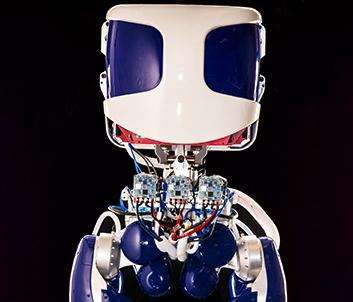June 17, 2015 weblog
DURUS makes impressive show of treadmill walking

DURUS from SRI is a walking humanoid robot with a competitive distinction of being efficient. Professor Aaron Ames, who heads AMBER Lab, the name of which appears on the robot contender under SRI Robotics, said it was considerably efficient, in presenting a video about the robot.
AMBER stands for Advanced Mechanical Bipedal Experimental Robotics Lab. Ames appeared in the video to tell viewers about the DURUS robot seen walking on the treadmill. He said that what's unique about this robot is the combination of (1) hardware development breakthroughs and (2) the algorithms running below the surface.
Evan Ackerman in IEEE Spectrum, meanwhile, provided some background to this demo; the DURUS showing was at the endurance challenge sponsored by DARPA, where robots from Sandia National Labs and SRI walked on treadmills with the goal of demonstrating their efficiency.
As for the mobility challenge itself, it was developed with the goal of building a humanoid architecture similar to the ATLAS robot but "20x to 30x more efficient," said Ackerman.
Ames made numerous points about what makes DURUS stand out; he said that "Throughout the competition, everyone will notice that the robots tend to hunch down and walk in a very slow and controlled fashion. In other words, very nonhuman-like."
That's not what we want to do, said Ames. "We want them to go where we go and do what we do."
DURUS' task in the competition was to walk for a very long time in a very efficient fashion on the treadmill on a continuous battery charge and seeing how long it could walk until the battery ran dry. How did it do?
Ackerman wrote in IEEE Spectrum: "We were there to see its final steps, and in 2 hours, 35 minutes, 43 seconds, DURUS walked 2.05 kilometers. While walking, it used about 350 watts of power, giving it an average cost of transport of about 1.5."
"For those of us who aren't electrical engineers, that's a really impressive feat. In fact, the DURUS uses up to 30 times less power than the ATLAS robot employed in the DARPA challenge," said Andrew Tarantola in Engadget.
The robot has everything on board, said Ames. No power cables. Nothing coming in from the outside.
What's next on Ames' wish list? Better better better, faster faster faster, said Ames. "We want more human-like foot behavior with the feet. We would like human-like heel toe contacts. Walking speeds that are dramatic."
AMBER Lab will move to the Georgia Institute of Technology next month. It was established in 2008 at Texas A&M University. Ames joins the Georgia Institute of Technology next month as an Associate Professor in schools of Mechanical Engineering and Electrical and Computer Engineering.
Readers may be confused over nomenclature, where they will see references elsewhere to a robot as PROXI and not DURUS. Ackerman explained the difference: "DURUS is a research platform for DARPA that's basically the lower half of a full humanoid that SRI is developing, which will (eventually) be named PROXI." The latter will meld experience with arms and hands with the efficiency of DURUS, said Ackerman, to create a low-cost high-performance electric humanoid that can walk for eight hours.
More information: www.sri.com/engage/products-so … anoid-robot-platform
© 2015 Tech Xplore




















